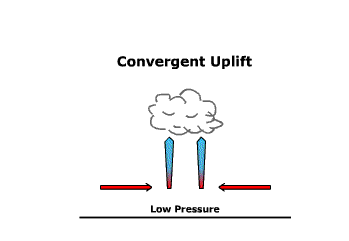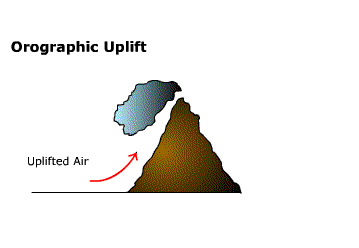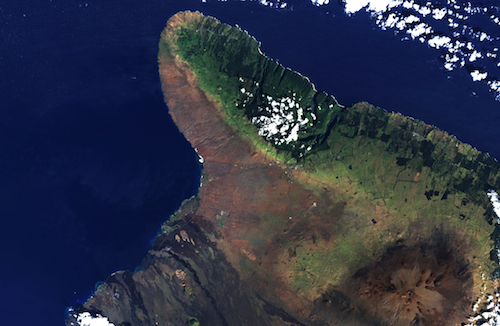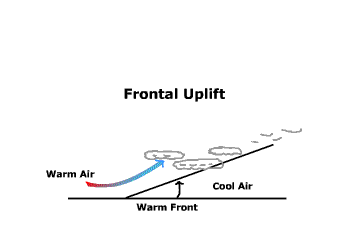|
Figure 7.8 Convergent uplift Convergent uplift occurs when air enters a center of low pressure. As air converges into the center of a cyclone it is forced to rise off the surface. As the air rises it expands, cools, and water vapor condenses. Convergent and convective uplift are the two most important uplift mechanisms for condensation in the tropics. Under the intense sun, surface heating causes the moist tropical air to rise. Convergence of the trade winds in the Intertropical convergence zone creates copious rainfall in the wet tropics as well.
Orographic uplift is the forced ascent of air when it collides with a mountain. As air strikes the windward side, it is uplifted and cooled. Windward slopes of mountains tend to be the rainy sides while the leeward side is dry. Dry climates like steppes and desert are often found in the "rain shadow" of tall mountain systems that are oriented perpendicular to the flow of air.A rainshadow in the lee of the tradewinds as they cross the mountainous northwest portion of the Big Isand of Hawaii (Figure 7.10). Cloud formation and green vegetaton identifies the windward, while the reddish brown indicates the dry leeward side.
Figure 7.10 Rainshadow on the Big Island of Hawaii. (Source NASA EOS)
Frontal uplift occurs when greatly contrasting air masses meet along a weather front. For instance, when warm air collides with cool air along a warm front, the warm air is forced to rise up and over the cool air. As the air gently rises over the cool air, horizontally developed stratus-type clouds form. If cold air collides with warm air along a cold front, the more dense cold air can force the warmer air ahead to rise rapidly creating vertically developed cumulus-type clouds.
Figure 7.11 Frontal uplift
Assess your basic understanding of the preceeding material by "Looking Back at Phase Changes of Water" or skip and continue reading. |

 Figure 7.9 Orographic uplift
Figure 7.9 Orographic uplift

